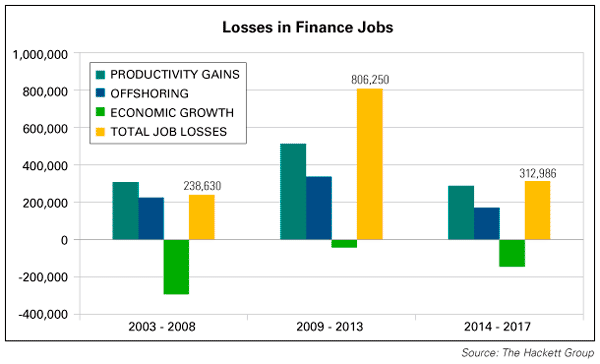 The number of finance and other back-office jobs at bigcompanies in North America and Europe will continue to decline overthe next few years, although the pace of such job losses isslowing, according to a recent report by The Hackett Group.
The number of finance and other back-office jobs at bigcompanies in North America and Europe will continue to decline overthe next few years, although the pace of such job losses isslowing, according to a recent report by The Hackett Group.
Hackett revised up its forecast for the number of businessservices jobs that will be lost in coming years in response to theInternational Monetary Fund's gloomier outlook on the globaleconomy. The business advisory firm recently estimated that another604,000 such jobs, including finance, HR, IT and procurementpositions, will have disappeared by the end of 2017.
|“We made a downward adjustment to these projections strictlyfollowing the IMF numbers,” said Erik Dorr, senior enterpriseresearch director at Hackett. “That paints a slightly bleakerpicture than we put out the year before.”
|The decline that Hackett is forecasting in overall businessservice jobs in coming years pales in comparison with the plungethat has occurred. Hackett reported a 38% drop, to just 4.9 millionsuch jobs in 2013, from 8 million in 2002. It now sees the numberof business services jobs bottoming out at 4.3 million in 2017,down from the 4.5 million total it forecast for 2017 in last year'sreport.
|Roughly half of the decline that Hackett expects over the nextfour years will occur in finance jobs. The firm expects a 312,986decrease in finance jobs at big companies in North America andEurope over the next four years. (See chart.) Its data show thatfinance jobs at such companies already contracted from 3 million in2002 to 1.9 million this year.
|
In addition to the IMF forecasts, Hackett's projections takeinto account data from its benchmarking studies about productivitygains and offshoring.
|Large corporations' use of technology to improve productivityand shifting jobs to cheaper offshore locations has not only driventhe losses in back-office work in North America and Europe, but hasled to a new standard for getting such work done, the globalbusiness services unit, according to Hackett.
|“The essence of what's going on is a redesign of the enterprisemodel for companies,” Dorr said.
|In the global business services unit model,companies have a separate unit that provides all the other businessunits with services like accounts payable and accounts receivable,IT or HR.
| Honorio Padrón, aprincipal at Hackett and leader of its global business servicespractice, said 78% of the companies Hackett benchmarks now have aglobal business services unit that performs two or more functions,although he noted those units are at varying stages of maturity.“It is a winning strategy, and more and more companies are figuringthat out,” said Padrón, pictured at left.
Honorio Padrón, aprincipal at Hackett and leader of its global business servicespractice, said 78% of the companies Hackett benchmarks now have aglobal business services unit that performs two or more functions,although he noted those units are at varying stages of maturity.“It is a winning strategy, and more and more companies are figuringthat out,” said Padrón, pictured at left.
Hackett's research shows that a company that moves work to aglobal business services unit can see its costs for that work cutby 19% in the first year and it will continue to realize recurringproductivity gains each year.
|Padrón attributes those results to the focus that a globalbusiness service unit can give to the work it does, the processimprovements it can implement and the competencies it develops.“When you put someone in charge of looking across the enterprisehorizontally, the connections get made in a better and moreefficient way,” he said.
|Dorr noted that global business services units also enjoyeconomics of scale.
|As more routine back-office work is automated or moved offshore,companies have less need of employees with transactional skills.But there is still good demand for “knowledge-centric” workers,according to the Hackett report, as well as a shortage of workerswith certain types of skills.
|“For the foreseeable future, there's going to be a shortage oftechnical skills,” Dorr said. “There is an explosion of newtechnologies like wireless and there's simply a lack of resourcesto do that kind of work.”
|“Someone will say, there are more jobs in the U.S. than everbefore in IT,” Padrón said. “But the growth is not in the backoffice, the growth is everywhere else.”
|There are three types of employees in great demand currently:those with expertise in change and transformation; those who canwork with data and make sense of it, in such areas as data analysisand data mining; and those who can manage services within thebusiness, Padrón said.
|As wages have headed higher in some popular outsourcinglocations, such as India, there has been talk that companies maybring some work back. But Padrón said it still makes financialsense to do work overseas.
|“There's been movement in some of the labor arbitrage beingreduced, but the variation is still so large that it does not makesense to bring all that back,” he said, adding that costs are alsorising in the U.S., and healthcare reform could push them stillhigher.
|Complete your profile to continue reading and get FREE access to Treasury & Risk, part of your ALM digital membership.
Your access to unlimited Treasury & Risk content isn’t changing.
Once you are an ALM digital member, you’ll receive:
- Critical Treasury & Risk information including in-depth analysis of treasury and finance best practices, case studies with corporate innovators, informative newsletters, educational webcasts and videos, and resources from industry leaders.
- Exclusive discounts on ALM and Treasury & Risk events.
- Access to other award-winning ALM websites including PropertyCasualty360.com and Law.com.
*May exclude premium content
Already have an account? Sign In
© 2024 ALM Global, LLC, All Rights Reserved. Request academic re-use from www.copyright.com. All other uses, submit a request to [email protected]. For more information visit Asset & Logo Licensing.







